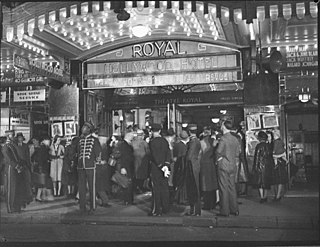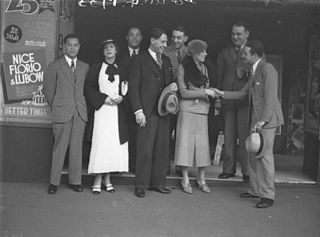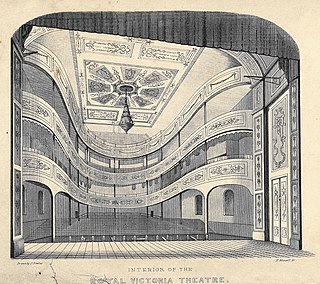Related Research Articles

Charles Bruce Dellit was an Australian architect who pioneered the Art Deco style in Australia. He was generally known as Bruce Dellit.

Thomas Rowe was a British-born architect, builder and goldminer who became one of Australia's leading architects of the Victorian era. He was also a politician, who was the first Mayor of Manly.

Her Majesty's Theatre, Sydney, Australia, refers to three theatres of the same name none of which remain standing. They were located in central Sydney on either Pitt Street or Quay Street.

Theatre Royal Sydney (TRS) is a theatre in Sydney, Australia. Earlier theatres also called the Theatre Royal, on the same site, date back to 1833. The current building, designed by modernist architect Harry Seidler, was built in 1976 and has offered a broad range of entertainment since the 1990s. After being closed in 2016, the theatre reopened in December 2021 under parent company Trafalgar Entertainment.

The Criterion Theatre was a theatre in Sydney, Australia which was built in 1886 by architect George R Johnson on the south east corner of Pitt and Park streets. It closed in 1935 and the building was demolished.
Ebenezer Vickery was an Australian businessman, pastoralist and philanthropist.

The Romantic Story of Margaret Catchpole is a 1911 Australian silent film directed by Raymond Longford and starring Lottie Lyell. It is based on the true story of Margaret Catchpole, an adventurer and convict. Only the first 24 minutes of the 50-minute runtime survives today.
The MacMahon brothers were entrepreneurs in Australian show business. Chief among them were James MacMahon and Charles MacMahon, who together and separately toured a large number of stage shows. Their younger brothers, Joseph and William, were involved in many of those activities.
The Life and Adventures of John Vane, the Notorious Australian Bushranger is a 1910 Australian silent film about the bushranger John Vane, who was a member of Ben Hall's gang. It was the first dramatic film from Charles Cozens Spencer who was a key producer of early Australian movies.
Spencer Cosens also known as Cosens Spencer or Charles Cozens Spencer, was a British-born Canadian film exhibitor and producer, a significant figure in the early years of the Australian film industry. His company Spencer's Pictures was an early backer of Raymond Longford before it was absorbed into the conglomerate which became known as "The Combine".

Dan Morgan is a 1911 Australian film from Charles Cozens Spencer about the bushranger Daniel Morgan. It was said to be starring "Alfred Rolfe and company". Rolfe directed three movies for Spencer, all starring himself and his wife Lily Dampier so there is a chance he may have directed this one and that it starred his wife. A prospectus for the Australian Photo Play Company said he directed it. It is considered a lost film.

The New Tivoli Theatre, Sydney, previously known as the Adelphi Theatre and the Grand Opera House, was a theatre and music hall at 329, Castlereagh Street, Sydney, Australia, which was long at the heart of the Tivoli circuit.

Alfred Gambier Newman was an Australian architect active in the first 20 years of the 20th century. He designed significant work for both the Methodist Church and the Newman and Vickery families.
Charles Thomas Newman, generally known as Rev. C. T. Newman, was a Methodist minister in South Australia and New South Wales.

The Royal Victoria Theatre, often referred to as the Victoria Theatre or The Old Vic, was a theatre in Sydney, Australia, the first large theatre in the city. It opened in 1838; operas, plays, pantomimes and other events were held, and leading entertainers performed at the theatre. It was destroyed by fire in 1880.
Joseph Wyatt was a theatre owner and manager, in the early years of theatre in Sydney, Australia.
William John Wilson was a British actor and theatre scenery painter, who had a career in Australia that included theatre management.
The Royal Lyceum was a small theatre in York Street, Sydney founded in 1854, which was redeveloped and renamed many times, finally as the Queen's Theatre, by which name it closed in 1882.
Patrick John Stephen, commonly referred to as Rev. P. J. Stephen, was a Methodist minister in Sydney, Australia.

Renee Evelyn Mary Lees was an Australian pianist, hailed as a child prodigy, later known as a theatre organist.
References
- ↑ "Advertising". Newcastle Morning Herald and Miners' Advocate . No. 6325. New South Wales, Australia. 22 January 1895. p. 1. Retrieved 29 September 2024– via National Library of Australia.
- ↑ "Sydney Shows". The Daily Telegraph (Sydney) . No. 13, 336. New South Wales, Australia. 7 February 1922. p. 9. Retrieved 16 October 2024– via National Library of Australia.
- ↑ "Theatredom and Movie Gossip". The Call (Perth) . No. 413. Western Australia. 13 April 1922. p. 7. Retrieved 12 October 2024– via National Library of Australia.
- ↑ "Liberty Theatre". The Sydney Morning Herald . No. 30, 020. New South Wales, Australia. 22 March 1934. p. 4. Retrieved 16 October 2024– via National Library of Australia.
- ↑ "New Liberty Theatre". Truth (Sydney) . No. 2308. New South Wales, Australia. 1 April 1934. p. 23. Retrieved 16 October 2024– via National Library of Australia.
- ↑ "Advertising". The Daily Telegraph (Sydney) . No. 4226. New South Wales, Australia. 11 January 1893. p. 7. Retrieved 29 September 2024– via National Library of Australia.
- ↑ "The Lyceum Pantomime". The Evening News . No. 7979. New South Wales, Australia. 27 December 1892. p. 3. Retrieved 19 September 2021– via National Library of Australia.
- ↑ "Rev. D. O'Donnell's Visit". The Pioneer . Vol. X, no. 525. South Australia. 16 May 1908. p. 2. Retrieved 29 September 2024– via National Library of Australia.
- ↑ "Wise and Otherwise". The Wyalong Star and Temora and Barmedman Advertiser . Vol. XII, no. 63. New South Wales, Australia. 11 August 1905. p. 2. Retrieved 29 September 2024– via National Library of Australia.
- ↑ "Two-Minute Chats". The Australian Star . No. 5869. New South Wales, Australia. 4 December 1906. p. 1. Retrieved 29 September 2024– via National Library of Australia.
- ↑ "In Memoriam". Spectator and Methodist Chronicle . Vol. XLI, no. 30. Victoria, Australia. 24 July 1914. p. 1187. Retrieved 29 September 2024– via National Library of Australia.
- ↑ "Samuel John Hoban, D.D." Australian Christian Commonwealth . Vol. 44, no. 2247. South Australia. 15 January 1932. p. 11. Retrieved 11 October 2024– via National Library of Australia.
- ↑ "Sydney Methodists Mourn Favorite". Sunday Times (Sydney) . No. 1831. New South Wales, Australia. 27 February 1921. p. 12. Retrieved 11 October 2024– via National Library of Australia.
- ↑ "Lyceum Hall". The Sydney Morning Herald . No. 21, 221. New South Wales, Australia. 12 March 1906. p. 3. Retrieved 29 September 2024– via National Library of Australia.
- ↑ "Future of the Lyceum". The Sydney Morning Herald . No. 21, 543. New South Wales, Australia. 4 February 1907. p. 6. Retrieved 29 September 2024– via National Library of Australia.
- ↑ "Opening of the Lyceum Hall". The Methodist . Vol. XVII, no. 16. New South Wales, Australia. 18 April 1908. p. 2. Retrieved 29 September 2024– via National Library of Australia.
- ↑ "Rev W. G. Taylor's Mission". Clarence and Richmond Examiner . New South Wales, Australia. 12 August 1909. p. 2. Retrieved 9 October 2024– via National Library of Australia.
- ↑ "The Churches". The Sydney Morning Herald . No. 24, 698. New South Wales, Australia. 3 March 1917. p. 7. Retrieved 9 October 2024– via National Library of Australia.
- ↑ "Real Estate". The Daily Telegraph . No. 13, 328. New South Wales, Australia. 28 January 1922. p. 14. Retrieved 12 October 2024– via National Library of Australia.
- ↑ Ian McIver. "Early Wurlitzer Piano-console Models [in Australia]" . Retrieved 13 October 2024.
- ↑ "Pitt Street Palatial Theatre". Sunday Times (Sydney) . No. 1885. New South Wales, Australia. 12 March 1922. p. 10 (Social and Magazine Section). Retrieved 12 October 2024– via National Library of Australia.
- ↑ "Valuable Bit of Pitt Street". Sunday Times (Sydney) . No. 2351. New South Wales, Australia. 15 September 1929. p. 16. Retrieved 13 October 2024– via National Library of Australia.
- ↑ "Rev. Potts' Death". Newcastle Morning Herald and Miners' Advocate . No. 17, 886. New South Wales, Australia. 9 February 1934. p. 10. Retrieved 17 October 2024– via National Library of Australia.
- ↑ "Morals or Money?". The Sun (Sydney) . No. 4164. New South Wales, Australia. 7 March 1924. p. 8. Retrieved 17 October 2024– via National Library of Australia.
- ↑ "10 Years' Lease". The Sun (Sydney) . No. 5719. New South Wales, Australia. 8 March 1929. p. 15. Retrieved 17 October 2024– via National Library of Australia.
- ↑ "Salon Cinema to Graphe". The Evening News (Sydney) . No. 9194. New South Wales, Australia. 21 November 1896. p. 3. Retrieved 2 October 2024– via National Library of Australia.
- ↑ "Theatrescope". The Referee (newspaper) . No. 973. New South Wales, Australia. 28 June 1905. p. 10. Retrieved 9 October 2024– via National Library of Australia.
- ↑ "An Old Sydney Playhouse". The Referee . No. 1317. New South Wales, Australia. 31 January 1912. p. 16. Retrieved 23 March 2021– via National Library of Australia.
- ↑ "Lyceum Hall Biograph". The Sydney Morning Herald . No. 21, 247. New South Wales, Australia. 11 April 1906. p. 14. Retrieved 9 October 2024– via National Library of Australia.
- ↑ "The Burns-Johnson Fight". The Register (Adelaide) . Vol. LXXIII, no. 19, 383. South Australia. 28 December 1908. p. 10. Retrieved 10 October 2024– via National Library of Australia.
- ↑ "Spencer's Pictures, Ltd". The Sydney Morning Herald . National Library of Australia. 21 September 1911. p. 11. Retrieved 1 July 2015.
- ↑ "Picture Shows". The Sun (Sydney) . No. 2249. New South Wales, Australia. 13 September 1917. p. 6. Retrieved 5 October 2024– via National Library of Australia.
- ↑ "A Moving Picture Drama". The Lone hand. September 1918. p. 444. Retrieved 8 October 2024.
- ↑ "Hoyt's Lyceum". The Sydney Morning Herald . No. 25, 087. New South Wales, Australia. 1 June 1918. p. 10. Retrieved 5 October 2024– via National Library of Australia.
- ↑ "Advertising". The Daily Telegraph . No. 12369. New South Wales, Australia. 1 January 1919. p. 10. Retrieved 5 October 2024– via National Library of Australia.
- ↑ "Lyceum Improvement". The Sun (Sydney) . No. 899. New South Wales, Australia. 20 June 1920. p. 20. Retrieved 11 October 2024– via National Library of Australia.